
I can’t really say when I first became interested in Joan of Arc. I can say that from a very young age I was quite interested in her story. I knew that she had been born and raised in a little village called Domrémy in France. I knew that she had been a martyr, burned at the stake in Rouen during the Hundred Years War. That part of her story saddened me, but it did not fascinate me.
What fascinated me was the fact that this simple country girl took on an amazing mission—to make her way across France in a time of war, against all sensible advice and in the face of what must have been overwhelming skepticism and derision—to find the proper king of France, and take him through enemy territory, to Reims to be properly crowned.
That alone is plenty of story for an imaginative child to wrap her mind around—but there is more, much more to know, as I would learn in time.
Deep in my mind and heart there must have been buried the desire to see the place she came from, though it wasn’t a very strong, or a very conscious desire. But when I found myself living in France many years later it occurred to me one day to see how far away I was from the place where she had spent her childhood.
It wasn’t that far. Less than a two-hour drive.
Over the next few years every once in a while I would ask someone I thought might be interested in such a venture, didn’t they think it would be interesting to go and see the birthplace of Joan of Arc?
But no one thought it would be. And since my desire to go there was not strong enough for me to undertake the trip myself, for years it remained a vague and unrealized desire.
Then, about a month ago, my friend Adrian called me and asked me what my plans were for Easter weekend.
I had none, which never bothers me. As an introvert I have no trouble at all staying home engaging in my favorite activities—reading, writing, walking—when I have nothing else to do. I have so much reading and writing to do! I will never catch up with it all.
But having no plans bothers Adrian. She likes to go places! And see new things! Pretty much nonstop. She likes her calendar to be full, and she knew that filling it on Easter weekend was going to be challenging because—well, because of Easter.
On this particular day she told me that she was getting a bit tired of just going back and forth from Paris, to Nice, and from Nice to Paris. She missed seeing other parts of France. She wanted to see some beautiful French countryside she hadn’t seen before. Could we take some kind of a road trip somewhere, using my home in Champagne as a base? Would I like to go on such an adventure with her on Easter weekend?
I said I would if I could propose where we would go. (It takes a lot to drag me out of my comfortable quiet life here, so I wanted to be able to choose our destination.) She said sure, and I said I’d get back to her.
That is when it occurred to me that this might be the moment I had been waiting for. So I took out the map again. And again I looked up the location of Domrémy-la-Pucelle— a couple of hours’ drive northeast of my home.
I figured that I could pick Adrian up at the train station in Vendeuvre-sur-Barse on Saturday morning and from there we could drive to Domrémy, see what was there, and then to go back to my place to spend the night. In the morning we could go to Easter mass at the beautiful cathedral in Troyes where Joan of Arc had stopped before going on to get the Dauphin crowned king of France in Reims.
There was only one potential problem. My friend Adrian is both Jewish and quite secular. Her interest tends toward museums, not churches and religious pilgrimage sites. Was this weekend going to be just way too Catholic for her?
I figured, though, that I could nicely balance the plan by suggesting that after all that Catholicism we could spend the afternoon having lunch in one of my favorite cafés in Troyes, and then visiting two very cool museums there—the Cité de Vitrail, and the Musée de l’Outil et de la Pensée Ouvrière.
So I sent her a text proposing my plan, and including a photo of this painting. (“This is the girl we’re looking for,” I said.)
“It will probably be a pretty drive,” I said when we got on the phone to confirm our plan, though I added that having never been in that part of France before I could not guarantee that. “Also I don’t know at all what to expect once we get there,” I told her. “There’s not very much information about it on the internet, but it looks like the house is still there. I don’t know if we’ll even be able to go inside.”
That was okay, she didn’t care. Clearly the journey was the thing.
So, a couple of weeks later I picked her up at the train station as planned, and we were off on our adventure. (You can read Adrian’s account of our journey and see the great photos she took that weekend here.)
But I will confine my report to talking about the deeply moving experience this was for me. And, as it is too much to contain in one post, this will be Part One.
Because of where our journey started, we ended up taking some very narrow departmental roads through eastern Champagne and into the Vosges department in Lorraine, where Domrémy is located. The weather was supposed to be rainy but fortune smiled on us, and it turned out to be a lovely day. As we got closer to our destination, Adrian remarked that there was a basilica somewhere near Domrémy. “Basilica,” I said. “That would be a very large church.”
And indeed it was. Here are the few photos I took there.
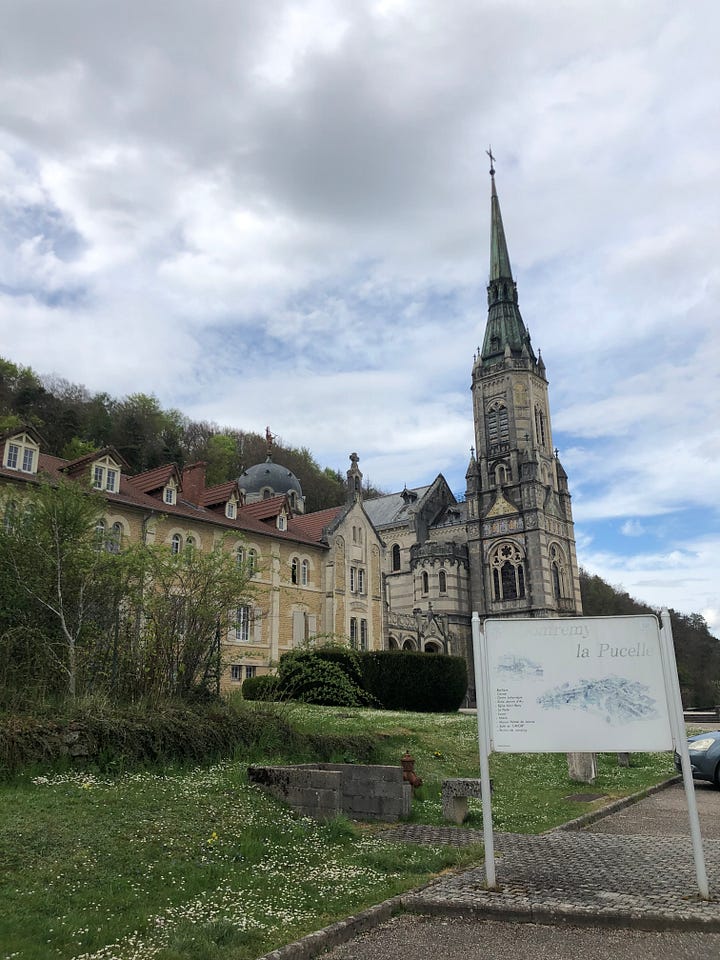
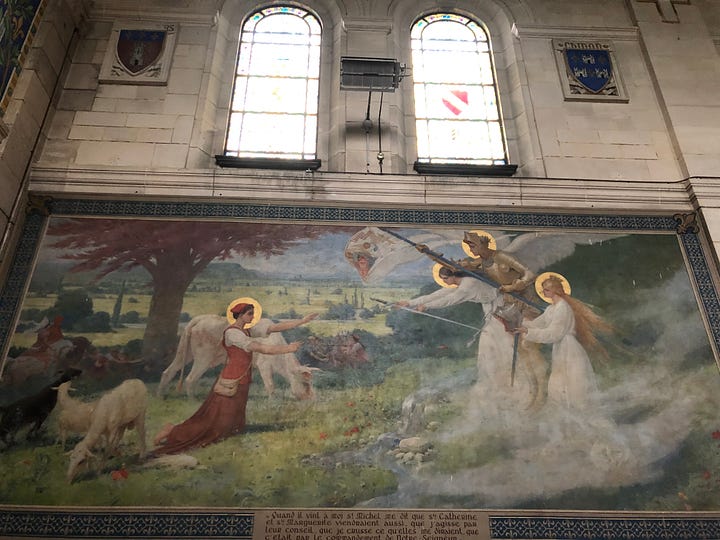

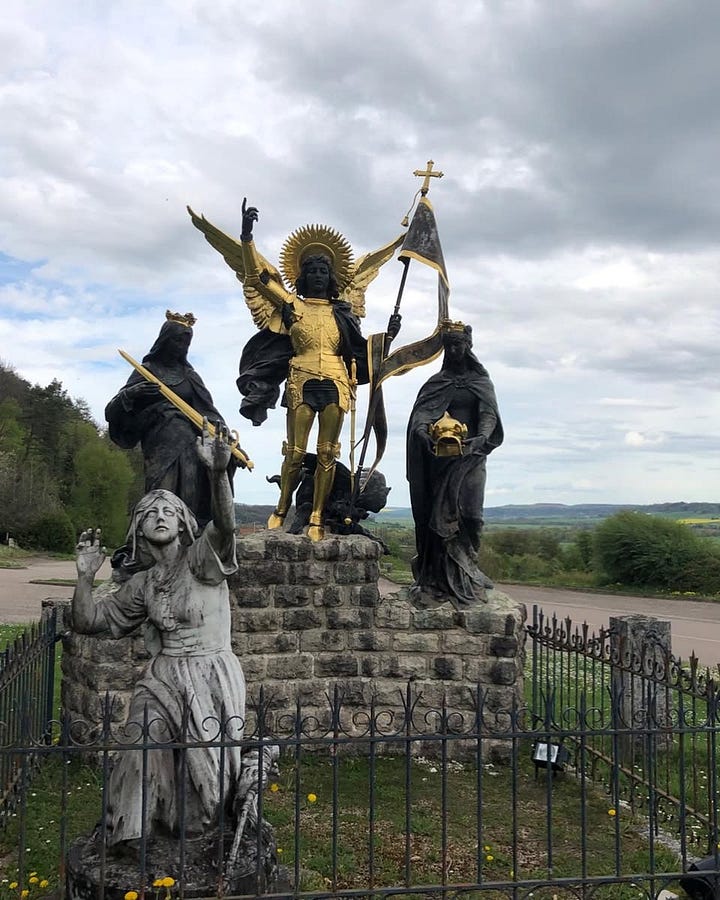
As you come out of the Basilica there are two very large statues anchored at the foot of the parvis. The one at the left is a man, seated next to a plow. At right is a woman seated next to a spinning wheel. They are identified as Jacques d’Arc and Isabelle Romée, and they are the parents of Joan.
I regret not taking pictures of these sculptures, which were commissioned by the Union internationale artistique de Vaucouleurs (Meuse), and dedicated in 1911. They are a poignant reminder of Joan’s humble roots, and I think a fitting tribute to their importance in forming her—and her mother’s role in restoring her name.
For Isabelle Romée apparently spent her long life seeking to restore Joan’s honor. She petitioned the Pope to reopen the court case that had convicted her daughter of heresy; in her seventies, she testified at the opening session of the appellate trial that was held in Notre Dame cathedral in Paris; and she died at age 81, two years after that appeal succeeded.
On May 16, 1920, four hundred and eighty-nine years after her death, Joan was canonized by Pope Benedict XV. Today, according to the Catholic News Agency, she is the patron saint of “soldiers, prisoners, those in need of courage, those ridiculed for their faith, and youth, among other things.”
And of course, she is also the patron saint of France.
Janet Hulstrand is an American writer, editor, writing coach, and teacher of writing and of literature who lives in France. She is the author of Demystifying the French: How to Love Them, and Make Them Love You, and A Long Way from Iowa: From the Heartland to the Heart of France; and coauthor of Moving On: A Practical Guide to Downsizing the Family Home.
ON THE TRAIL OF JEANNE D’ARC PART TWO:
Adventures in France
In Part One of this adventure I wrote about how I was able to fulfill a vague, but nearly lifelong, desire to visit the birthplace of Joan of Arc.

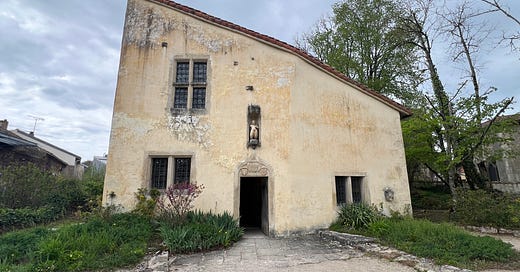


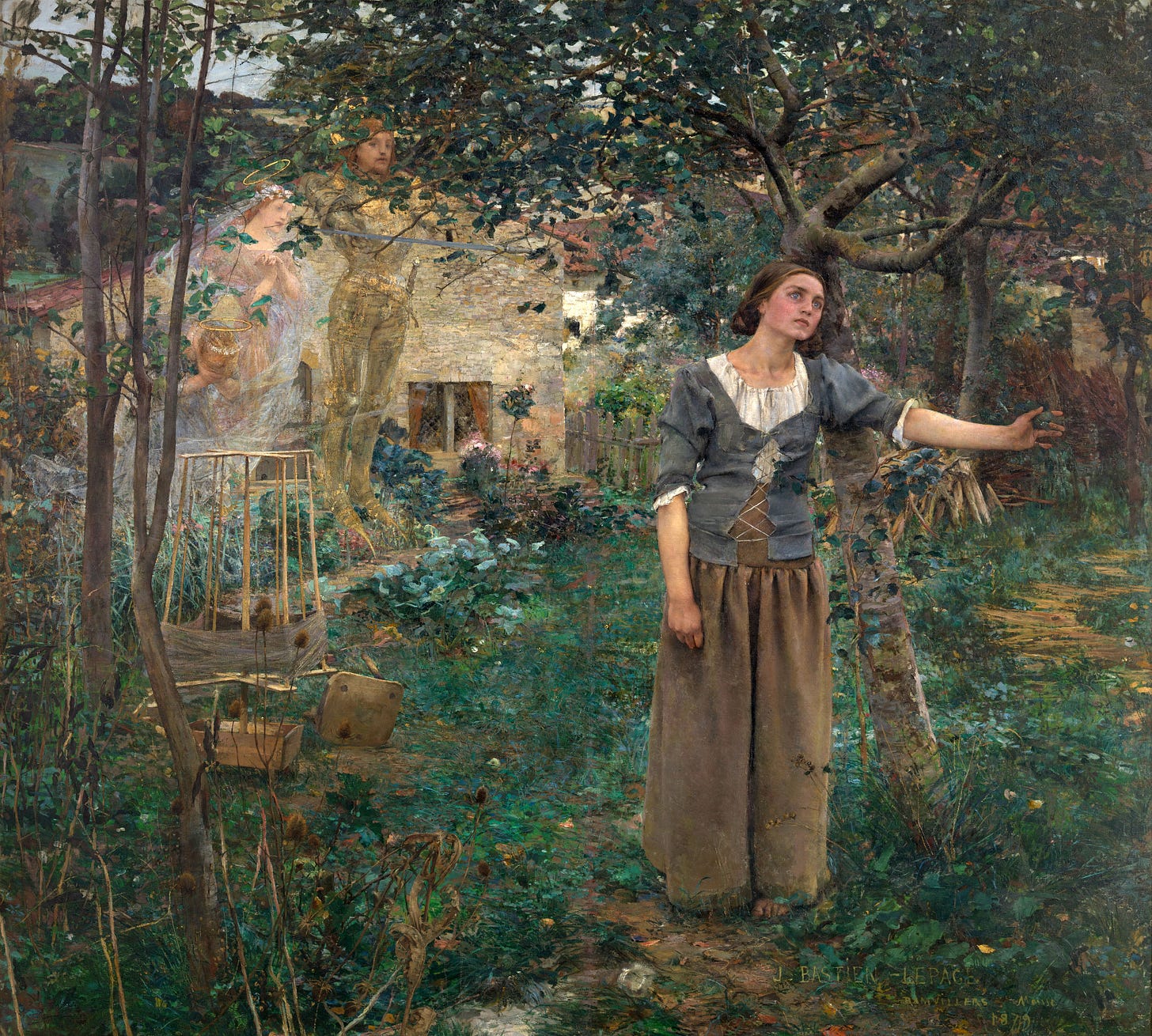
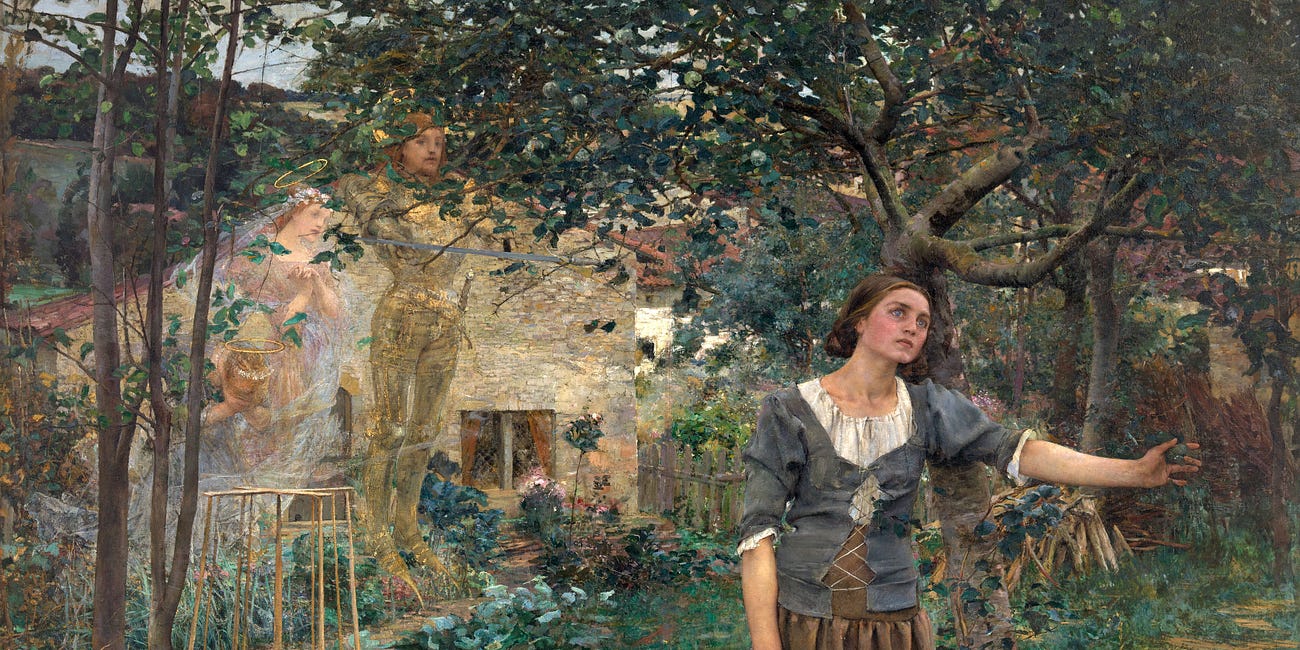
Thank you for sharing. I was lucky enough to visit Reims, France in August of 1999 as it was the last solar eclipse of the millennium. Totality passed right through the city. Right outside of the Reims cathedral is a statue of Jeanne d'Arc on horseback. I'm not sure who did it but someone had climbed up and put on a pair of solar goggles on the statue's face. I'll never forget experiencing a total eclipse in Reims. Great to learn more about Jeanne.
Since childhood I have been intrigued by the story of Joan of Arc and wondered if I would have her courage should the occasion arise. Waiting for Part Two.